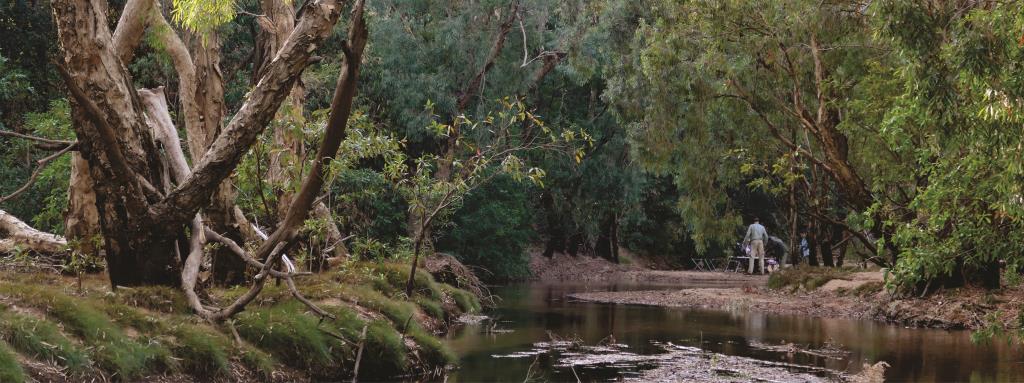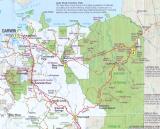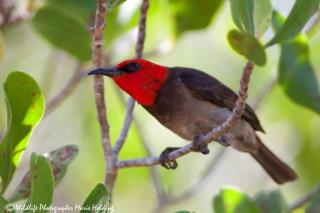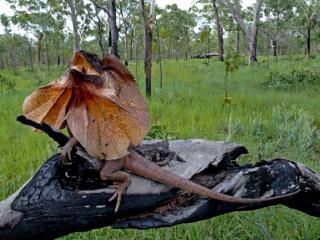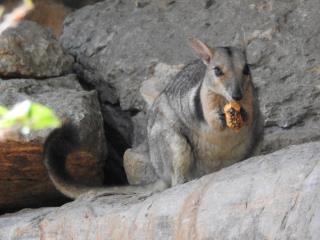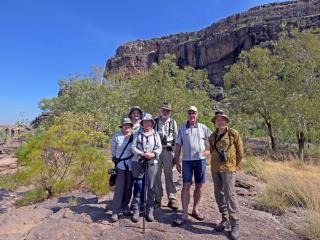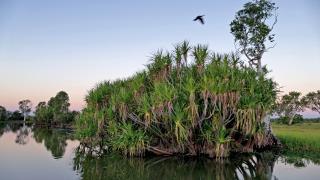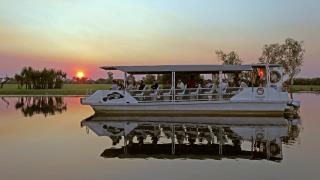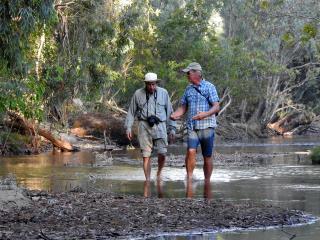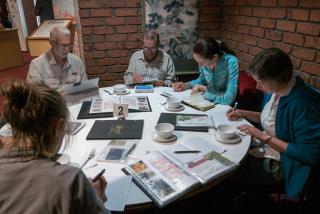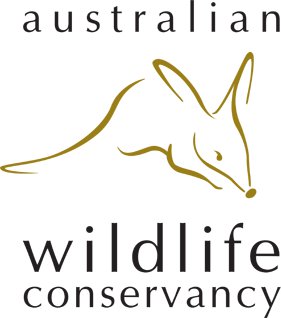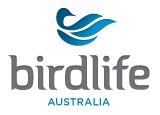6 Day Kakadu Naturalists' Tour
Immersion in Nature in Darwin, Kakadu and Litchfield with Ian Morris
-
Six day, five night tour starting with woodland and wetland habitats in the Mary River region then through to the dramatic sandstone escarpments and wetlands of Australia's largest National Park, Kakadu. We explore open savannah country around Pine Creek then back to Darwin via Litchfield National Park. Total distance covered - 1200 kilometres. See map.Kakadu Naturalists Tour - The numbers show where we spend each night of the tour (photo copyright Tourism NT)
- Key species - Rainbow Pitta, Green-backed Gerygone, Broad-billed Flycatcher, Crimson Finch, Long-tailed Finch, Gouldian Finch, Hooded Parrot, Northern Rosella, Red-winged Parrot, Cockatiel, Red-tailed Black Cockatoo, Buff-sided Robin, Partridge Pigeon, Black-tailed Treecreeper and Sandstone Shrike-thrush. Red Goshawk, Black-breasted Buzzard. Kakadu escarpment endemics such as Chestnut-quilled Rock-pigeon, White-lined Honeyeater and Banded Fruit-dove.
- Will this tour suit me? With the added value of Ian’s expert guidance, Kakadu will yield even more of it’s secrets to enthusiastic nature lovers seeking a unique opportunity to encounter birds, reptiles, mammals, invertebrates and plants. In addition, the cultural heritage of Kakadu will feature strongly throughout this trip. All accommodation is in comfortable air-conditioned rooms with ensuites. We start before dawn and stop for a bush breakfast at beautiful locations surrounded by birdlife at its busiest. Lunch is enjoyed out in the field and dinners are ala carte menus at resorts or restaurants. Enjoy an after dinner slide presentation by Ian on subjects relative to the days exploration. Group is small, with a maximum of only five keen fellow naturalists, plus Ian and Mike.
- Cost - $4495 per person twin share, single supplement $495
- 2021 dates - Unfortunately we are not scheduling this tour for 2021, please click here for a similar tour
"Mike
Bjorg and I want to thank you and tell you what an amazing wonderful trip you provided. Bjorg was skeptical of this trip because she is not a hiker or a birder and at her age now prefers nicer accommodations than those on several previous eco or nature trips. She now raves about all aspects of this tour as do I.
As you now probably have sensed I adore all aspects of nature. I was taken in by the topography, plants and especially the trees, birds, particularly the larger ones, and animal life that we witnessed. You and Ian are founts of knowledge about all of these and dispensed it in a comprehensive yet succinct and easy to digest way. Each day was full without being over tiring. Giving us aspects of Australian history and particularly for me about the Aborigines was important.
Reading about the meals in your brochure made me a bit skeptical of same, but the food and accommodations were all quite good-well beyond adequate.
You and Ian made a good team with thorough knowledge and experience of all that you described. Any time you have professionals with the expertise you both possessed will make for a great experience, and we were certainly not disappointed in this regard. You had everything so well organized that the tour ran seamlessly. We also congratulate you for your consideration and kindness towards all of us in this diverse group.
So, thank you, thank you, thank you. If we can ever be of service as a reference feel free to use us.
Warm regards
Bjorg and Richard
USA August 2015
Here is a short video of highlights from our 2017 Kakadu Naturalists' Tour
About Ian Morris: Ian Morris is a biologist, educator, conservationist and author of ‘Kakadu National Park’ and co-author of ‘A Natural History and Field Guide to Australia’s Top End’. He has worked with Aboriginal Traditional Owners of the Arnhem Land region for decades, and was involved in forming Kakadu National Park. Ian promotes the magic of the bush as an NT based environmental consultant for many national parks in Australia.
Ian Morris learnt his first Aboriginal language at the age of nine in East Arnhem Land, and eventually went back there as a school teacher. He mentored and continues to mentor many young indigenous children, and has himself been mentored by Aboriginal elders in the Indigenous understanding of relationships with nature. He has been involved with Kakadu National Park since it’s inception in the 70’s and has written and co-authored many books on the wildlife and ecology of the region. Ian has an understanding and rapport with animals (including Homo sapiens) like no other person I know.
Here is a transcript of an interview with Ian about Kakadu in 2005. Ian features in this episode of the ABC documentary 'Kakadu' see him from 19min on or enjoy the whole documentary and the other three Kakadu episodes (Episode 1, Episode 3, Episode 4). Warning: If you watch this you WILL want to come!!
DAY 1 - DARWIN to MARY RIVER
Pick up from Darwin accommodation - 6.30am
We make the 60 kilometre drive out to Fogg Dam and have a bush breakfast with the animals and birds that make this place so special. We drive along the dam wall where we may see Magpie Geese, Intermediate Egret, Little Egret, Great Egret, Pied Heron, Royal Spoonbill, White-browed Crake, Black-necked Stork and sometimes Brolga. Whistling Kites, Black Kites and often a White-bellied Sea-eagle soar overhead. Crimson Finch, Rufous-banded Honeyeater, Lemon-bellied Flyrobin, Rose-crowned Fruit-Dove, Forest Kingfisher, Sacred Kingfisher and Paperbark Flycatcher are some of the species that occupy the bush on the edge of the floodplain and are often seen in the carpark area. Estuarine Crocodiles, Gilberts Dragon’s, Yellow-spotted Monitors, Northern Long-necked Turtles and Golden Tree Snakes may be seen here.Then we explore the Waterlilies walk which takes us along the fringe of wetland, through paperbark forest. We often see Rainbow Pitta, Brown Whistler, Arafura Fantail and Shining Flycatcher.
We continue on to the Mary River Wilderness Retreat and explore the 'Bamboo Walk' that follows the edge of the Mary River.
Dinner and accommodation is in a comfortable, air-conditioned Bush Bungalow at Mary River Wilderness Retreat.
We go through the checklist of sightings for the day at dinner then enjoy Ian's after dinner slide talk - 'Introduction to the Top End'
DAY 2 - EXPLORE MARY RIVER
Bush breakfast at Bird Billabong.
We spend the morning exploring savannah woodland country around Bird Billabong and then continue on to
Kakadu National Park and the South Alligator River region.We do the monsoon forest walk at Gungarre and the Anggardabal Billabong, then continue on to the Bowali Visitor Centre.
Accommodation is in a comfortable, air-conditioned, cabin at Kakadu Lodge.
We go through the checklist of sightings for the day at dinner then enjoy Ian's after dinner slide talk - 'Natural and Cultural Values of the North'
DAY 3 - EXPLORE KAKADU
Bush breakfast at Mamukala.We head out early to Mamukala bird hide. We do the four kilometre loop walk at sunrise, encountering many savannah and wetland species, then have some breakfast before checking out the bird hide.
We continue on to Ubirr, we explore the Manngarre Monsoon Forest walk, Cahill’s Crossing and Bardedjilidji Sandstone Escarpment walks, searching out some Kakadu escarpment endemics such as Chestnut-quilled Rock-pigeon and White-lined Honeyeater. Other species on our target list are Partridge Pigeon, Rainbow Pitta, Shining Flycatcher, Northern Fantail, Arafura Fantail, Little Red Flying Fox and Wilkin's Rock Wallaby.
We take in some spectacular ancient rock art and a magnificent view across the Nadab Floodplain.
Accommodation is in a comfortable, air-conditioned, cabin at Kakadu Lodge.
We go through the checklist of sightings for the day at dinner then enjoy Ian's after dinner slide talk - 'Never Stay in One Place - Bill Neidjie's story'
DAY 4 - EXPLORE KAKADU
We head out early to the Burrunggui rock and Anbangbang area (Nourlangie), and after a bush breakfast at Anbangbang Billabong, we do the 12 km 'Barrk Walk' around Burrunggui Rock. This is a spectacular walk with magnicent views and wildlife viewing opportunities. We will see more ancient Aboriginal rock art, and possibly more endemic species such as Banded Fruit-dove, White-lined Honeyeater, Sandstone Helmeted Friarbird and Black Wallaroo. Other species we will look for include Emerald Dove, Northern Rosella, Partridge Pigeon and Spangled Drongo.
We have a picnic lunch at Mardagul and then do the short Mardagul Billabong walk. Then we visit the Warradjan Cultural Centre which offers an amazing insight into local Aboriginal culture and history. There is also a well stocked cultural and natural history bookstore and authentic souvenir shop.
At 4.10 we depart for the famous Yellow Waters cruise. From the comfort and safety of an open sided, covered vessel we are likely to see four species of Egret - Great, Intermediate, Little and Cattle as well as Black-necked Stork, Brolga, Radjah Shelduck, Wandering and Plumed Whistling-ducks, Green Pygmy-goose, Pied Heron, Nankeen Night-heron, Comb-crested Jacana, Royal Spoonbill, Azure Kingfisher, Little Kingfisher, Buff-sided Robin as well as many large Estuarine Crocodiles. What is particularly amazing about this cruise, is that, because it runs four times a day, every day of the year, the birds and crocodiles are so accustomed to it that they continue on in their natural behaviour completely undisturbed by the presence of the boat.
We pause on sunset and take a few minutes to absorb the splendour of the location as the sun dips below the horizon, often with hundreds of birds flying overhead to their night roosts. Then it’s the short drive to the resort to for dinner.
Accommodation is in a comfortable, air-conditioned, cabin at Cooinda Lodge.
Ian's after dinner slide talk - 'The Wetlands of Kakadu'
DAY 5 - KAKADU to PINE CREEK
We then depart Jabiru via Kakadu Highway and have a bush breakfast alongside a river bed. We explore southern Kakadu on the way out. The country changes and so does the bird sighting possibilities.
We visit Gunlom and look for more Kakadu endemic species. We check out a nesting location for Red Goshawks and visit a site where Silver-backed Butcherbirds are reliable and a very rare cycad grows.
We continue on to Pine Creek and check out some reliable areas for Hooded Parrot! Other target species here are Banded Honeyeater, Bar-breasted Honeyeater, Rufous-throated Honeyeater, Budgerigar, Cockatiel, Red-winged Parrot, Varied Lorikeet, Great Bowerbird and Grey-crowned Babbler.
Accommodation and dinner at Pine Creek.
We go through the checklist of sightings for the day at dinner then enjoy Ian's after dinner slide talk - 'Termites - Friend or Foe'
DAY 6 - PINE CREEK to DARWIN
Early bush breakfast by a river bed south of Pine Creek, where we often see Gouldian Finches, Cockatiels, Hooded Parrots, Northern Rosellas and then head north towards Darwin.
We enter Litchfield National Park, visiting and stop to view some magnificent waterfalls and the wildlife in the area. Here we may find Dingo, Short-eared Rock Wallaby, Olive Python, Merton’s Water Monitor, Spangled Drongo, Blue-winged Kookaburra, Great Bowerbird, Pheasant Coucal, Pied Butcherbird and Silver-backed Butcherbird. This is also one of the few locations where the amazing magnetic termite mounds are found.
We head back to Darwin now via the back route which takes over the beautiful Finniss River. Both Estuarine and Johnston’s Crocodiles are present here. If there is time we will expore birding hotspots around Casuarina Coastal Reserve, Lee Point and Buffalo Creek.
Our last dinner together and review of highlights for the day and the trip, is at a restaurant in Darwin. We say our goodbyes and drop off you at your Darwin accommodation.
Please Note: The above itinerary is based on the outcomes of many previous tours to the areas described. Ian Morris’s experience in the area is vast, and his expertise could lead to some unexpected and memorable wildlife experiences. Each season is different and as various wildlife observing opportunities arise, adjustments will be made.
Inclusions - Five nights comfortable air-conditioned accommodation, Yellow Waters Sunset Cruise, bush breakfasts, picnic lunches and main meals, Kakadu Park entry fees. Cold water, tea and coffee and refreshments available at all times.
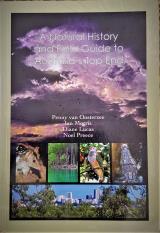
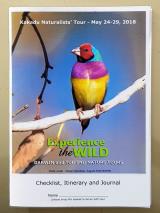
A comprehensive checklist/journal is provided which will help each participant to make the most of this tour. Each evening after dinner we review the days experience as a group, tick off all the species we have seen, and then view a slide-show presentation featuring a theme to be explored on the following day.
Also included is a free copy of ‘A Natural History and Field Guide to Australia’s Top End’ by Ian Morris et al. This is a 202 page full photos (nearly all Ian's) and information on climate, habitats, geology flora and fauna of the Top End.
Exclusions - Alcoholic drinks, purchases of a personal nature such as souvenirs, internet use, etc.
Group - $4495 per person twin share, single supplement $495.
All prices are in Australian dollars. Please click here for conversion to your currency.
Booking Procedure - You can book directly using our secure online booking site by clicking here. Payment options are Visa, Mastercard, Paypal or Bank Transfer. A 20% deposit secures the booking, the balance is due 30 days prior to start of tour. Please feel free to contact us if you have any queries regarding the tour.
Download a printable copy of this itinerary
Click Here to Check Availability and Book Now!
Further Information - Visit our FAQ page to learn more about how our tours run. Visit our 'Darwin Accommodation' links page to find some helpful suggestions for pre and post tour arrangements. Our Terms and Conditions document outlines our cancellation and refund policy. Email enquiries@experiencethewild.com.au or ring Jenny or Mike on 0400 404 058
Please Click Here for Other Birdwatching Itineraries
